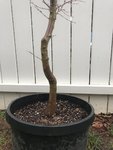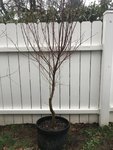Sir_Nixon
Seedling
Hello All,
I would love some advice/comments from everyone with my new maples that I have recently acquired from a nursery ($40 each!). Both maples were just hand dug from field growing for the last 4-5 years and was planning my next steps for this coming spring. I plan on practicing air layering with both of these at several locations along the tree once there tree is healthy and thriving, and will need to regrow new roots, since the roots on both trees are horrible and shoot straight down unfortunately.
1) Since they were recently dug from the ground, would it be smart this spring to clean the roots, ground layer or tourniquet above the existing roots and replant in the ground for a couple years to establish a new root system?
2) what would be the best technique to get new roots? tourniquet?
3) Also where would be the best place to truck chop after air layering? I have attached photos of the trees and some photos of where I would do the air layering and possible trunk chop options
Thanks for your input!!





I would love some advice/comments from everyone with my new maples that I have recently acquired from a nursery ($40 each!). Both maples were just hand dug from field growing for the last 4-5 years and was planning my next steps for this coming spring. I plan on practicing air layering with both of these at several locations along the tree once there tree is healthy and thriving, and will need to regrow new roots, since the roots on both trees are horrible and shoot straight down unfortunately.
1) Since they were recently dug from the ground, would it be smart this spring to clean the roots, ground layer or tourniquet above the existing roots and replant in the ground for a couple years to establish a new root system?
2) what would be the best technique to get new roots? tourniquet?
3) Also where would be the best place to truck chop after air layering? I have attached photos of the trees and some photos of where I would do the air layering and possible trunk chop options
Thanks for your input!!







